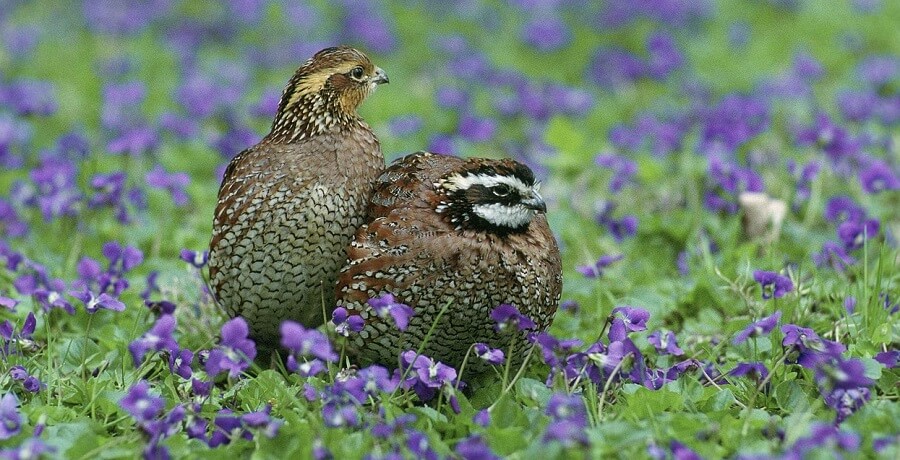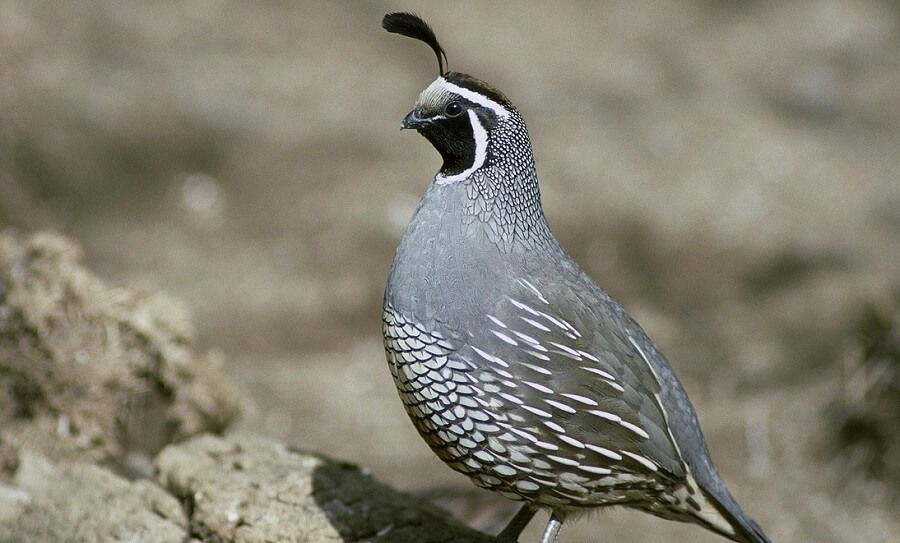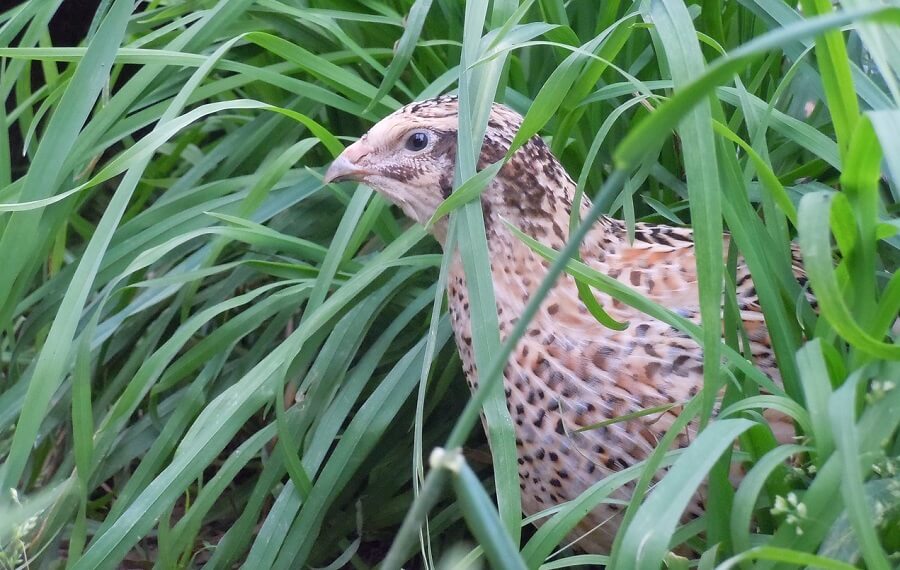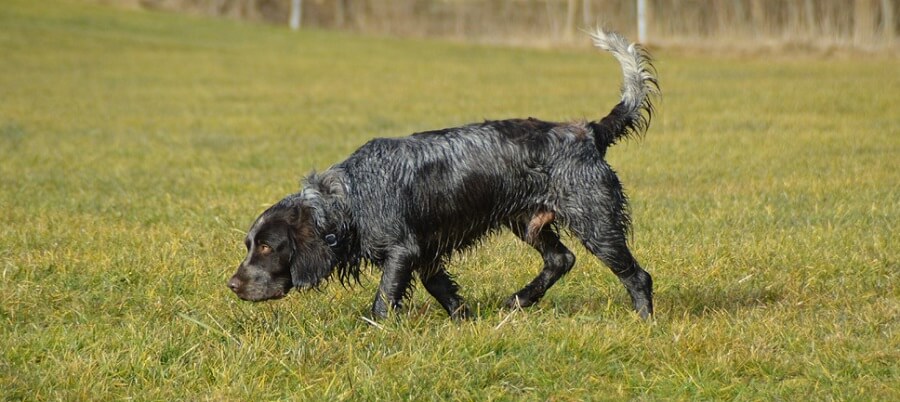Quail are small, quiet birds that can be raised in the city or the country. They are raised for eggs, meat and hunting. In most parts of the world, they are considered a delicacy. They kept the Israelites alive in the wilderness for 40 years and the pilgrims feasted on them.
Quail eggs and meat makes a fantastic substitute for chicken meat, but raising quail is a lot different than raising chicken.
This article will cover everything that you need to know about raising quail including how to raise them in the city or how to free-range them. It will cover raising quail from eggs, cheepers, chicks, or adult quail. It will also cover lots of questions about quail.
13 Steps To Raising Profitable Quail
1. Decide What Types Of Quail You Want To Raise
There are dozens of types of quail to raise. Even some of the most popular breeds have dozens of sub-varieties that are incredible for eggs or meat.
Two types of quail are the most popular quail to raise. The Coturnix quail and the bobwhite quail. The Coturnix is also called the Pharaoh or Japanese quail and has been domesticated for thousands of years. It is a calmer quail that doesn’t scare as easily and makes a wonderful pet.
Coturnix are solid egg layers and less likely to be startled to death. They are also the most common type raised for meat.
Coturnix is native to Russia, Asia, and parts of Europe. Coturnix can start laying eggs as early as 6-8 weeks, which is also when they can be used for meat.
Bobwhite quail are native to the United States and Northern Mexico. It is a more wild and flighty bird. Bobwhites are usually raised either for meat or for training hunting dogs and in hunting reserves. Bobwhites are usually the only quail allowed to be released in the USA, but some areas still require a permit.
They grow larger than Coturnix but take longer to mature. Bobwhites take 22 weeks before they are developed enough for a good flight. They also take longer to lay eggs, about 16 weeks. The hens only lay from April to September.
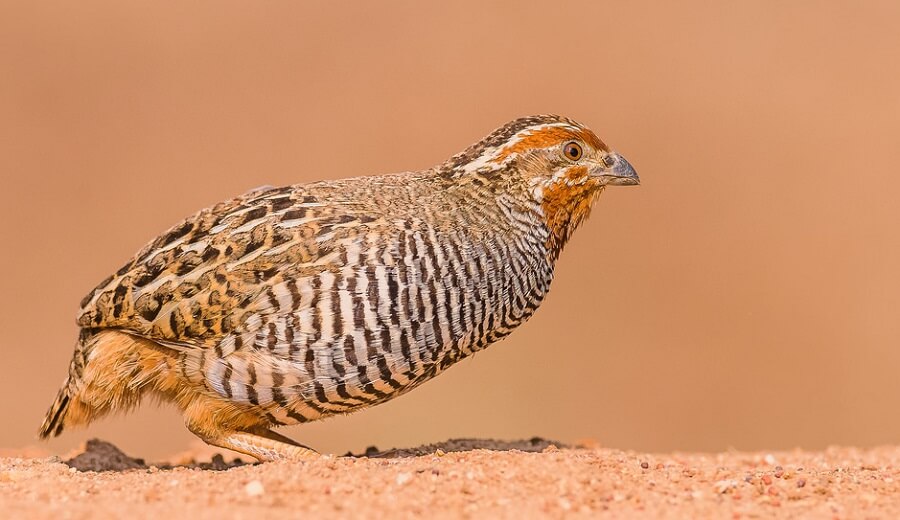
Jungle Bush Quail
2. Decide What Age Of Quail To Raise
Some quail farmers buy quail eggs and incubate them while others prefer to buy hatchlings. Others still prefer chicks that are 4-5 weeks old and past the most fragile stages of raising quail.
Incubating quail eggs is fairly simple to do. With an incubator, and turning the eggs regularly, most or all of your quail eggs will hatch.
Cheepers, or day-old chicks, are the most fragile quail to raise. They will be tamer if handled from a young age. Quail will scare less easily than a bird that is not handled as a hatchling. Hatchlings require a brooding box, a heat source, and safety precautions.
Young adult quail are much less likely to die or get sick. Some people prefer to raise them at about 6-8 weeks old because they are older and harder.
3. Incubate and Brood Quail
Most quail farmers raise quail from the eggs or from day hatchlings. To raise quail from eggs, be sure to get a reliable incubator. There are many types and some of them fail to keep consistent temperatures. Check out my best animal homes page for my recommended housing options. Most fertilized quail eggs will hatch and most quail eggs are fertilized.
Once the quail hatch, you will need to take extra precautions with your hatchlings. They will need to be kept warm, fed, and watered. You will also need to keep them in a clean brooder or they are likely to get sick. Quail are the most fragile in the first two weeks.
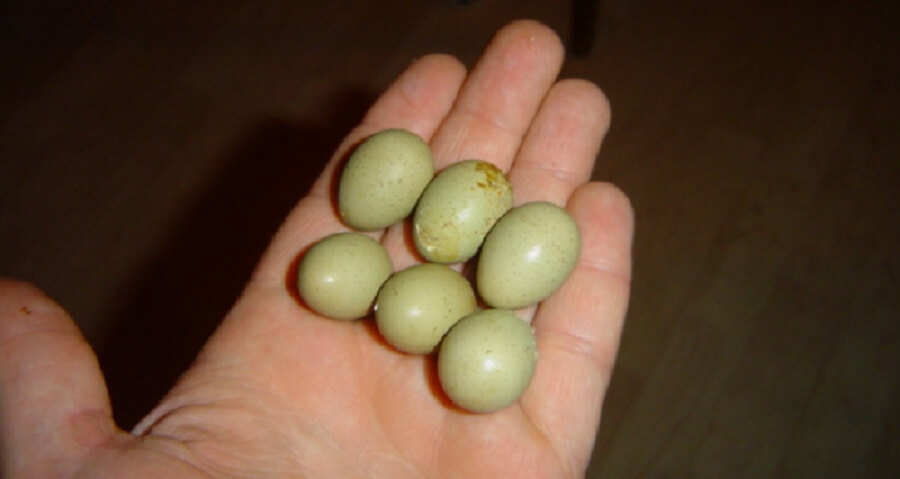
4. Set Up The Quail Cage
After six weeks, you can move your quail to their permanent home. This can be a cage kept indoors, on your apartment balcony, or outside where you free range them. (Note: free-ranging quail is different than free-ranging chickens because quail are very good at flying.)
Most people keep quail in a cage or a hutch. They are made in a variety of styles. Some cages have a slightly inclined floor so the eggs roll to one side for easy collection. Many also have slotted or wire bottoms so that the quail waste falls down and can be collected outside the cage. This helps to keep them clean easier, but doesn’t give them access to the ground, which quail love.
5. Feed Quail Game Feed
Quail are a wild game bird so they need a lot more protein than chickens do to be healthy. Although you can feed quail a non-medicated chicken feed temporarily, they really should be fed a higher protein meal. This is my preferred game feed for turkeys, quail, peacocks, and guinea fowl. I order it on Amazon.
Quail won’t overeat. That means that even if extra food is available, they will only eat and drink what they need. This makes it easy to gauge if you are feeding them too much or too little food.
| Protein % | Calcium % | Phosphorus % | Methionine % | |
| Bobtail Starter 0-6 weeks | 23.0 | 1.0 | 0.50 | 0.50 |
| Bobtail Finisher Meat | 19.0 | 0.90 | 0.50 | 0.40 |
| Bobtail Developer Flight | 20.0 | 0.90 | 0.50 | 0.42 |
| Bobtail Developer Breeder 6-20 weeks | 18.0 | 1.0 | 0.50 | 0.40 |
| Bobtail Layer 20+ weeks | 19.0 | 2.75 | 0.65 | 0.50 |
| Coturnix Starter 0-6 weeks | 24.0 | 0.85 | 0.60 | 0.50 |
| Coturnix Meat Finisher 6+ weeks – market | 18.0 | 0.65 | 0.50 | 0.40 |
| Coturnix Layer 6+ weeks | 18.0 | 2.75 | 0.65 | 0.45 |
Provided by http://extension.msstate.edu/
6. Water Quail
Quail need adequate water to stay healthy. However, young quail can also drown in water trays. Keep quail hydrated by providing them with continuous water. You can use a chicken waterer tray that keeps the water available to quail consistently or provides water to them daily. Change water bowl daily to keep it clean.
Young quail can drown in watering containers so consider putting a mesh over it or adding marbles to keep them from being able to be submerged in the water.
7. Clean Up Quail Cages
Quail poop should be cleaned out of the cage daily. Their cages should be washed down and dried poop cleaned up. Quail poop has ammonia in it and can become stinky.
8. Adjust Quail Food For Laying Quail
Once quail start laying they will need more protein, calcium, and phosphorus. Their diets should be adjusted. You can provide oyster shells as a means of extra calcium.
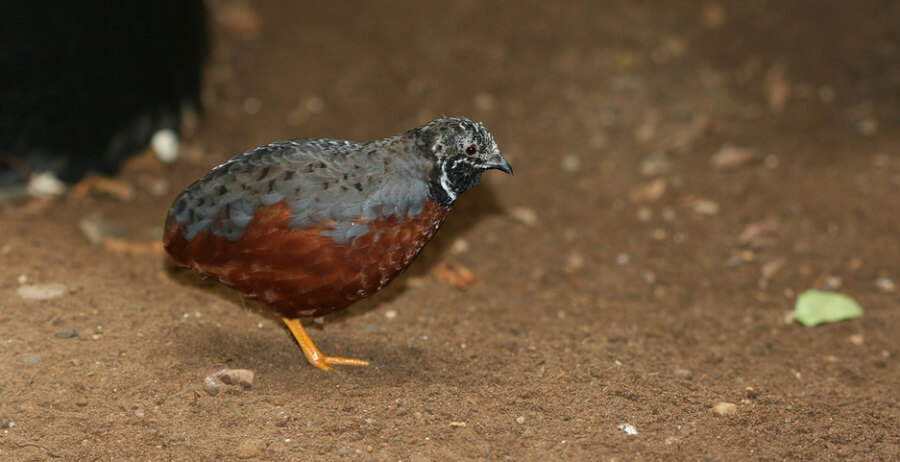
9. Provide A Light During The Darker Months
Quail need at least 14 hours of light each day to continue laying. As the fall and winter sets in, provide them enough light to keep females laying. This can be done with a timed light that turns on before dawn and off after dusk. This is better than an all-night light which doesn’t provide quail a natural day and night.
10. Keep Quail Protected From Fright
Quail scare easily. They can actually cause themselves a heart attack when they are startled and die from the scare. Thus it’s important to keep them protected sudden fright. There are several ways to protect quail from scaring.
First, if you have other animals such as a dog or cat, keep them separated from the quail. Both animals are predators of quail and will scare the quail, even if a cage stands between them. If your quail are being raised in a larger cage, consider putting a visual barrier on the lower 3 feet of the cage.
You can also keep quail in a different room than your pets are allowed.
11. Provide Quail Calcium and Grit
Quail need calcium to lay good eggs. Oyster shells are a healthy way to provide calcium to quail. Grit can be provided through sand or chicken grit. It helps quail to break up their food. Quail don’t have teeth and they use grit to help them grind down the food for digestion.
12. Give Quail A Dirt Bath
Just like chickens, quail love to bath vía a dirt bath. You can provide a dirt bath to your quail by giving them a container with fine sand in it. You can also provide a sand and fireplace ash mix. Your quail will roll and cover themselves in dirt. This helps them to get rid of bugs and other pests in their feathers. It cleans them up and keeps them more sanitary.
13. Have The Right Male To Female Ratio
The number of males to females will depend on your quail setup. If you are housing your birds altogether, then you want to have about 2-4 females per male in your hutch. This is because the male birds can easily keep those many females busy and can fertilize that many eggs. This higher female to male ration will produce the highest number of hatched chicks per bird.
But, if you are keeping your quails in smaller cages of 2 quail per cage, then you will need a single male for each female. This will produce the highest number of eggs and hatchability per bird.
Make sure you don’t have too many males in a population of females. This will lead to bullying and possibly the death of some of your males. There will be a definite pecking order among your male birds and a lot of competition if there aren’t multiple females per male.
Some breeders will have as many as 10 hens per male in a group.
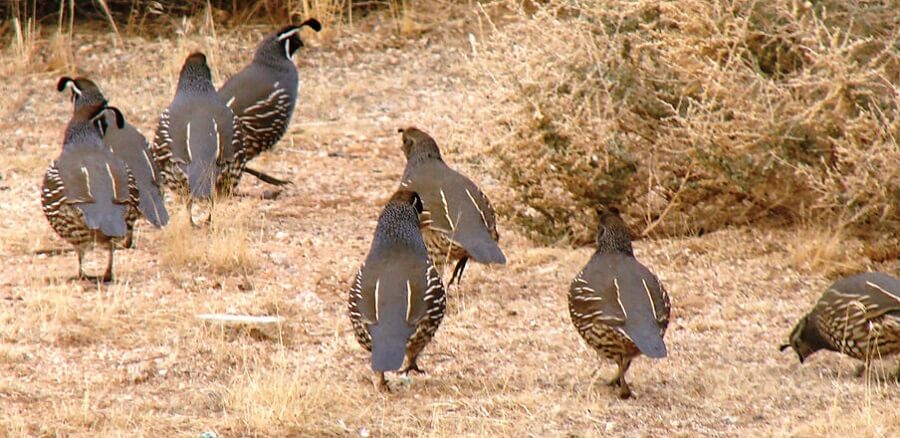
One male to 3 females
Raising Quail In Apartments
Quail can be raised in large cages in an apartment, on a balcony, a rooftop or in your backyard. Quail are quiet and need much less space than chickens. Instead of 10 sq feet per chicken, quail only need 1 foot. The Coturnix quail has been raised for thousands of years in Japan as a meat and egg bird.
Even when cities have ordinances restricting the raising of chickens, they generally don’t restrict quail raising. They often allow it or don’t mention quail at all in the law.
Quail are smaller and generally have a quiet cooing sound. On occasion, the males can be a little more chirpy. If you have a male that is noisier, you can either sell, eat, or give it away. You don’t need male quail to have laying females unless you are raising quail from eggs as well.
Quail need 1 foot of space for each bird to be healthy. This means that you don’t need a lot of space to raise 3 or 4 birds. Quail will generally lay 1 egg a day all year round. So you could easily have 3 or 4 eggs a day, with just a 2×2 cage.
Your cages should only have a height of about 1 foot. Quail fly straight up and can kill themselves hitting the roof of a tall cage.
Many city-dwellers raise quail in stacked hutches and in this manner are able to produce quite a lot of quail eggs each day. You can also raise quail in rabbit hutches or other bird cages but makes sure to keep the cages clean.
The eggs can be sold to restaurants, as well as the birds. Quail farming is very feasible even in a large city and a small space.
- Quail need 1 foot per bird
- Quail can be stacked in cages
- They can be kept in an apartment, on a balcony, or raised on a rooftop
- Most cities don’t prohibit raising quail
- Quieter than chickens
- Cages should be only 1 foot high to prevent death by flight.
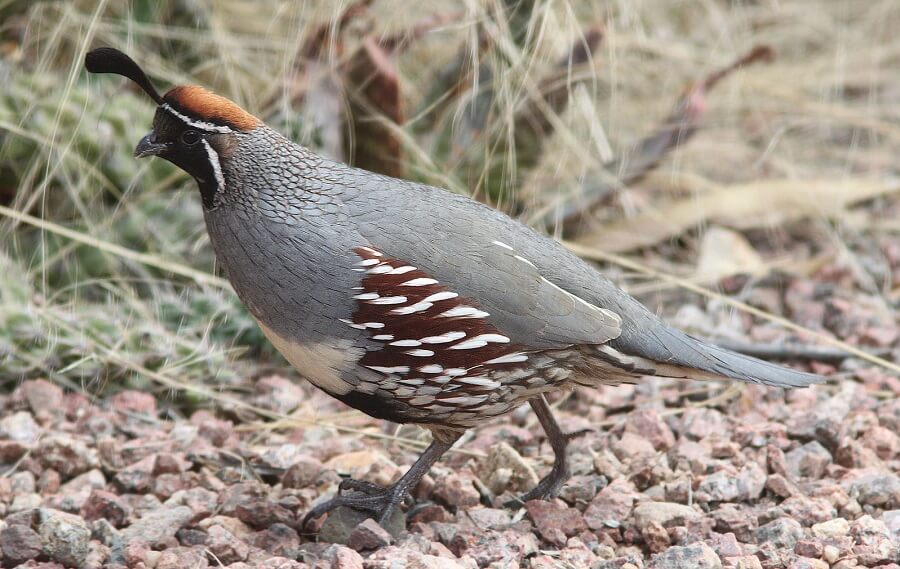
Free-Ranging Quail
Raising quail on the ground gets them more acclimated to the wild. They are more used to the weather and make them happier because they are in their natural habitat. Quail are ground birds, which means that they like to stay on the ground, although they are fantastic fliers also.
If you plan to raise your quail to train as hunting birds, they will do better if they are raised on the ground because they will be more adjusted.
After you bring them outside from the brooder, make sure to provide them with a heat lamp for the first week. A simple light bulb will provide extra heat while they get adjusted.
Free-ranging quails is different than chickens. Because they are flight birds, you will need to make a few adjustments.
First, quail will need to be free-ranged with a roof over their heads. This can be a mesh that keeps the quail from flying away or it can be a high roof.
If you are going to provide them a flying hutch, then the roof should be high enough that they aren’t likely to hit their heads and get hurt or it can be netting that won’t cause shock to them. When startled, quail fly straight up. This often causes death if they hit the roof.
A solid roof should be 8 feet or higher. Most quail won’t go much higher than 6 feet high because they do like the ground. You can also use deer netting or another netting between a roof and the quail to act as a soft guard for the quail that take flight.
Another option is to provide a short quail hutch. The hutch should be no more than 1 foot off the ground to prevent them from taking flight.
Quail can be free-ranged using a chicken tractor that can be moved around to provide them ample grass and ground to cover. Move the tractor to keep them on fresh grass.
Quail poop contains ammonia so you can use it around other birdhouses to help ward off predators.
If you use a quail tractor, make sure that it is built to keep predators out. Use hardware cloth to keep raccoons, weasels, foxes, and other animals from tearing through the fencing. Move the tractor to discourage predators from digging underneath. You can also use an outside border fence around your tractor to keep predators out. Or, put a wire mesh along the bottom of your hutch so the quail can feel the ground, but predators can’t dig their way in.
- Quail are naturally ground birds and love the natural ground
- They fly easily so need a roofed cage
- Quail are easy prey
- Cages need to be predator proof
- Hunting quail do best with flight cages
Raising Quail From Eggs
Collect or buy eggs that are fresher than 3-4 days. You can keep them up to 3-7 days old at 65 degrees. The age of the eggs includes the number of days old they were when you purchased them. If you purchased 3-day old eggs, you can immediately incubate them and don’t wait more than 4 more days to start incubation.
You can keep them as long as 10 days, but it will affect how many will hatch. 15 days will make it really hard to hatch any of them.
Put them in an incubator and keep them at a temperature of 99.5-100 degrees.. They take about 24 days to hatch. You will need to turn them every 3 days (after the initial 3-7 day waiting period)
It is more difficult to raise chicks from a broody hen. Quail hens don’t tend to brood well and will usually leave their eggs to the elements and outdoor temperatures. If you want to brood the eggs, you are better off to put the eggs under a good brooding chicken and have her brood the eggs.
- Eggs should be less than 7 days old for the best hatching results
- Incubate at 99.5 degrees
- Rotate eggs every 3 days
- Quail hatch at 27 days

Raising Quail Chicks
Cheepers are much easier to raise than hatching quail from eggs. Buy day-old chicks. Always purchase more than one bird because quail are social birds and won’t be happy alone. Keep your new cheepers quarantined for at least three weeks before you introduce them to the rest of your flock. This will help to keep them from getting sick or passing any sickness along.
Quail chicks need more care and attention than grown quail and this also allows you to provide that care.
The brooder should be kept indoors. A garage or shed will work well. It needs to be protected from wind and breeze. It should be warm and dry. You will also need to keep it clean so the chicks don’t get sick.
You can keep 4-6 chicks per foot for the first 2 weeks. 4 chicks can be kept per square foot until 6 weeks. If still brooding chicks after six weeks, you can have 3 chicks per foot. Some varieties of quail, such as the Coturnix are fully grown at 6 weeks so they will need 1 square foot per chick at six weeks.
Keep the chicks warm with a heating lamp. Keep the brooder warm and decrease the temperature as the chicks get bigger.
- Week 1: 95-97 degrees F
- Week 2: 90-93 degrees F
- Week 3: 85-87 degrees F
- Week 4: 80-83 degrees F
- Week 5: 75-77 degrees F
- Week 6: Provide a heat lamp outdoors if acclimatizing them to live in an outdoor hutch.
Chicks need light as well. Provide them with a light at all times. This will help to keep them from attacking each other and will keep them happier. It also reduces cannibalism. Use a 100 watt light the first few days, after that, a lower watt bulb will work.
You can combine the light with the heating lamp or if using a ceramic heat lamp, provide additional light for them.
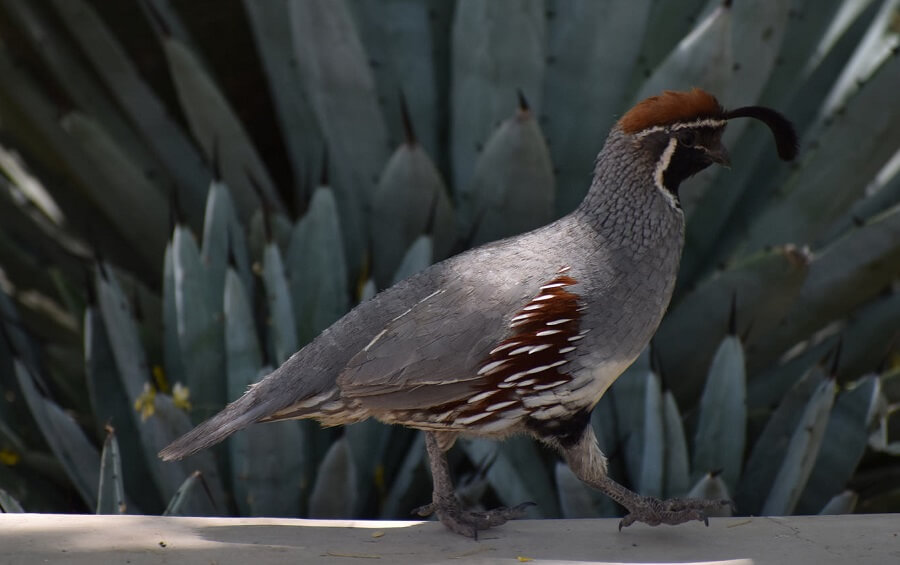
Desert Botonical Quail
Raising Healthy Adult Quail
Quail are wild game birds and aren’t naturally climatized for living in cages or pens. They are also a small percentage of domesticated birds. As a result, they are easily prone to sickness and there aren’t a lot of medicines approved for quail use.
However, you can keep a healthy flock of quail if you do several things to help them stay well. If you buy young adult quail to introduce into your existing flock, be sure to quarantine them for at least a week before you introduce them to your other birds. This will help to ensure that they don’t bring any sicknesses with them.
- Don’t crowd quail. Give quail at least 1 sq foot per quail
- Clean their water dishes daily
- Clean feeders weekly
- Clean cages daily and change bedding
- Clean crusted waste weekly from cages
- Feed clean, fresh feed to birds, never moldy food
- Take out sickly or dead birds immediately from the flock
- Only introduce young quail into an existing flock
- Quarantine outside birds before introducing them to your flock
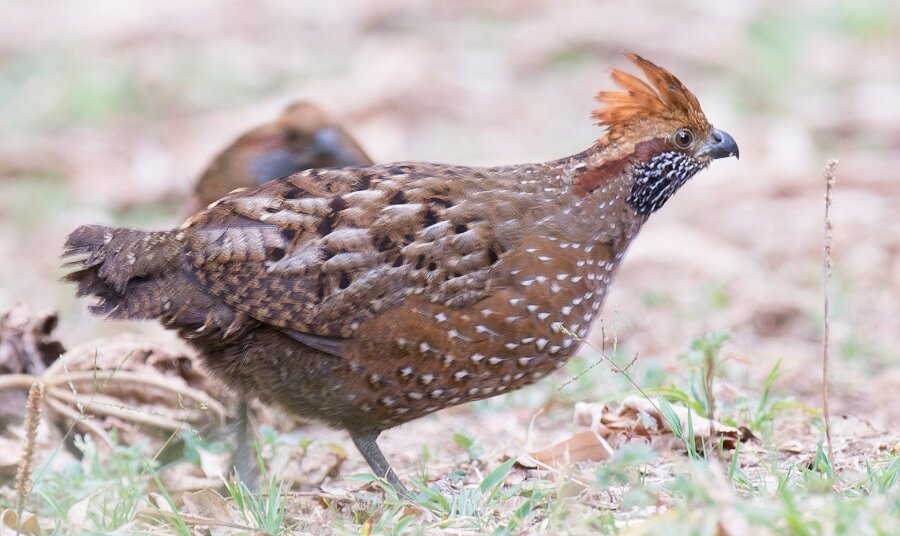
Spotted Wood Quail
Raising Quail for Meat
Some varieties of quail are full-sized at 7 or 8 weeks. Compare that to chickens, which take much longer. If you are raising a lot of quail, you can get more meat faster and more consistently in the same amount of space as you could raise chickens.
Certain species of quail are used more often for meat birds than others.
Coturnix quail are very popular for meat and eggs. Tibetan Coturnix quail are the breed most often served in restaurants. They are disease hardy and calm birds. Coturnix is also called the Japanese quail.
Bobwhite quail are also raised for meat.
Raising Quail for Eggs
Some breeds of quail will start laying eggs at about 6-8 weeks. That makes them earlier layers than chickens. You will have eggs months before your same-age chicks will start laying. Quail eggs are considered a delicacy.
Your quail hens will lay daily throughout the year. However, you will need to provide a light source to keep them laying in the winter months. Quail need 14 hours of daylight to continue laying. They also need protein and calcium.
You can set up a light on a timer then turns on before dawn and off after dusk. Set it for 14 hours of light. Quail love oyster shells as a healthy source of calcium.
Raising quail for eggs can be done for your own dining needs or to sell to restaurants. If you are using quail eggs, you will notice that they are tougher than chicken eggs. Quail egg cutters make cracking them easier.
Even in the city, quail are simple and easy to raise. They are usually ⅓ the cost of a chicken hatchling and require much less space.
It usually takes 3-5 quail eggs to equal a single chicken egg.
Do Quail Produce Fewer Eggs Than Chicken? Meat?
You might think that because quail are smaller birds and they lay smaller eggs, they produce less meat than chickens. However, some breeds of quail are fully grown as early as 6-8 weeks and will start laying eggs about that time. Chickens take about 6 months to start laying eggs, with even the early egg layers taking 4-5 months.
Plus, quail take less space than chickens.
As a result, if you have the same amount of space for both chickens or quail, you can raise a lot more quail than chickens in that space. Because quail are fully grown in a month, instead of 4-6 months, they can be harvested for food a lot more often and they produce a lot more eggs than a chicken does.
This means that you can actually get more eggs and more meat from quail than you can from chickens. It’s true that it takes more animals to get there, but in the same amount of space and time, you would get meat faster and more often.
How To Raise Quail For Hunting Or To Release
Flight pens are needed if you plan to raise quail to release into the wild or to use as training for hunting dogs. If you plan to release quail into the wild, be aware that in the US, bobwhite quails are usually the only quail that is allowed for release.
That’s because other types of quail aren’t native and can introduce bird diseases into the local population, killing thousands of birds.
Plus, other bird varieties, such as the Coturnix are mild and are more likely to be killed by predators than they are to survive.
The flight pen should be away from city noise and traffic. It should be in a quiet area so that the quail don’t acclimate to human noise and activity. This will keep the quail from responding appropriately to a hunter.
The pen should be about 40 feet long and at least 7 or 8 feet high. It should be wide enough that you can till or drive a small tractor into it. This will allow you to till the ground and keep it clean for all your birds. Flight birds need 2 feet of space per bird to be healthy.
Flight birds should be fed a starter feed for the first 6 weeks. At 6 weeks, they should be switched to a developer feed.
- Starter feed: 24% protein, 1% calcium, 0.5% phosphorus and methionine
- Developer feed: 20% protein, 0.9% calcium, 0.5% phosphorus, 0.42% methionine
Birds should have the food and water elevated to about the height of their backs for the best watering and feeding. Place a metal grate around the feeding and watering area so that the birds aren’t standing in the wet ground and waste while feeding.
Birds raised on the ground will be able to have dirt baths, but you can also provide a dirt bath solution of fine sand and ash for them to dirt bathe in.
Raising Quail With Chickens
Quail should never be raised in the same pen as chickens. There are a variety of reasons for this. Chicken are heartier than quail and can carry illnesses that are easily passed on and will kill quail.
Chickens are much larger than quail and can easily kill quail, even accidentally. They are also predators and will kill and eat mice. It is common for a chicken to prey on quail and eat them. Chicken love quail eggs and will often poach the eggs.
Chicken and quail have different nutritional needs. Quails need more protein than chickens do. If you feed quail and chickens together, the chickens will eat the quail meat and leave the chicken meat for the quail. This will mean you have fat unhealthy hens and undernourished quails.
Chicken coops and quail hutches often use different materials. Quail need a roof over the top of the hutch so they don’t fly away. Chickens are often free ranged during the day, but quail can’t be let out or they will fly away.
- Chickens will kill quail because of their larger size
- Chickens are bullies in the yard
- Chickens will eat quail
- Chickens can pass deadly illnesses to quail that don’t affect the chickens
- Chickens need less protein than quail
- Quail can’t be free-ranged during the day with chickens
How Much Space Do Quail Need?
Quail need only 1 square foot of space per quail. Their cages should be only 1 foot high to prevent injury. Flight quail need 2 square feet of space per quail and a higher roof so they can fly.
How Many Eggs Do Quail Lay?
A quail hen will start laying eggs as early as 7 weeks. She will lay daily throughout the year. Hens need light to continue laying in the winter months. They will also need enough calcium and protein or healthy eggs.
Do Quail Stink
Quail poop has ammonia in it. That means that their waste is pretty stinky. If you plan to keep quail indoors, you will probably need to clean the cages twice a day or the smell can be overwhelming.
If you are raising quail outdoors on a balcony, in the backyard, or on the roof, then daily will be sufficient for cleaning their cages.

